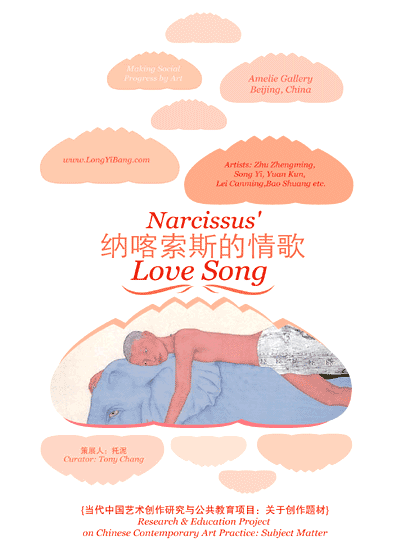
Letter from Curator
by Tony Chang
"When a culture is in a state of disintegration or transition the freedom of the artist increases-but the question of subject matter becomes problematic for him¡¬" That is British art critic John Berger's view on the artistic crisis of late 19th century Europe. After over thirty years of development, Chinese contemporary artists now face the challenge of finding new subject matter to reflect the contemporary spirit. In essence, artistic creation is the recognition and probing of the self. Sincere artists are like the young Narcissus of Greek mythology, falling in love with their beautiful reflections in the water, infatuated with their spirits, and their creations are the love songs that these artists write to themselves.
Since ancient times, developments in art history have always followed changes in the subject matter of artworks. Artists, driven by their unique spiritual personalities, constantly seek new life experiences and ways of seeing the world, exploring their own existence to discover unique perspectives from which to cast light on universal human nature and soothe the spiritual anxieties of their eras. John Berger proposes two (often intertwined) paths to developing new subject matter: the discovery of new life experiences and innovations in ways of seeing. The former can be seen in Van Gogh's painting of potato eaters or old leather boots, or in Gauguin's painting of South Pacific islanders; the latter can be seen in Cezanne's efforts to turn his way of seeing into the subject of his artworks, creating landscapes out of geometric forms and subverting traditional Western landscape painting¡¬ Their efforts refreshed the moldering subjects of late 19th century French salon and Acad¨¦mie painting. Picasso's subject matter revolved around his relationships with his lovers, encapsulating a passion that transcended carnal desire. He once said, "I see, for others, that is to say, in order to put on canvas the sudden apparitions which come to me. I don't know in advance what I am going to put on canvas any more than I decide beforehand what colors I am going to use. While I am working I am not conscious of what I am putting on the canvas. Each time I undertake to paint a picture I have a sensation of leaping into space. I never know whether I shall fall on my feet." Picasso's later paintings, with decrepit old men, and monkeys looking on nude women, reveal fear of old age and the fragility of life. Pop artist Andy Warhol chose direct and unadorned themes. He was frank about his choice to make silkscreen printings of dollar bills: I like money, so I painted the dollar.
[gallery link="file" orderby="title"]
In my interactions with Bart Dekker, esteemed collector of Asian art and founder of artinasia.com, he told me that "The cynical realism and Cultural Revolution memories of the time of Fang Lijun and Zhang Xiaogang are easy for Westerners to understand; the creations of today's Chinese artists are growing increasingly private, obscure and minute; the viewer, lacking in detailed research of that artist, finds himself lost." As contemporary art practice has developed with greater depth, the individual dreams and anguishes of a diversifying society have created a pattern of increasing privatization. When the heavens are silent, the people speak. Today's era awaits a new spokesperson to use the mirror of his heart to reflect the halo of the era.
Among the love songs of the great poets, T.S. Eliot's Love Song of J. Alfred Prufrock uses a Hamlet-style soliloquy to refeal the conflict between a sensitive soul and a cold world: if Shakespeare's Prince Hamlet had self-confidence, and Nietzsche imagined that he had self-confidence, Prufrock had been diminished to the point that he lost the power of self-confidence. The poet, staring into the abyss of the heart, pondered Western society's ignorance of human nature in the progression of industrialization. The artwork is a testament to the fact that the depth and width of the spiritual ventures that the artist sends out from within will determine whether or not his subject matter or even the final artwork will stand the test of time. This poem is a lasting masterpiece of modernist poetry. It was written between 1910 and 1911, when the poet was only twenty-three; the spiritual self-explorations of Chinese artists today in their twenties and thirties are still stuck on a very shallow level.
When Narcissus was born, his parents asked for a sign from the gods so that they could know his fate. The gods responded, "Do not let him know himself." We all know what became of this young Greek. For the artist, the love song of Narcissus is not necessarily overly emotional romanticism, groundless lamentations or empty imitations (while among many contemporary artists' creations we often see similar, imitative subjects, superficial ideas and simple dithering¡¬); serious artists must engage in long, arduous self-probing: does the selected theme incisively point to the most hidden depths of my spirit? Does the spiritual world presented in the art have a unique richness and provide new insight into contemporary culture?
About the exhibition
Dates: July 14th-August 29th, 2012
Venue: Amelie Gallery
Curator: Tong Chang
Participating Artists: Sun Man, Zhu Zhengming, Song Yi, Yuan Kun, Ye Huiling, Lei Canming, Chen Linlin, Bao Shuang.
Courtesy of the artists and Amelie Gallery.




























